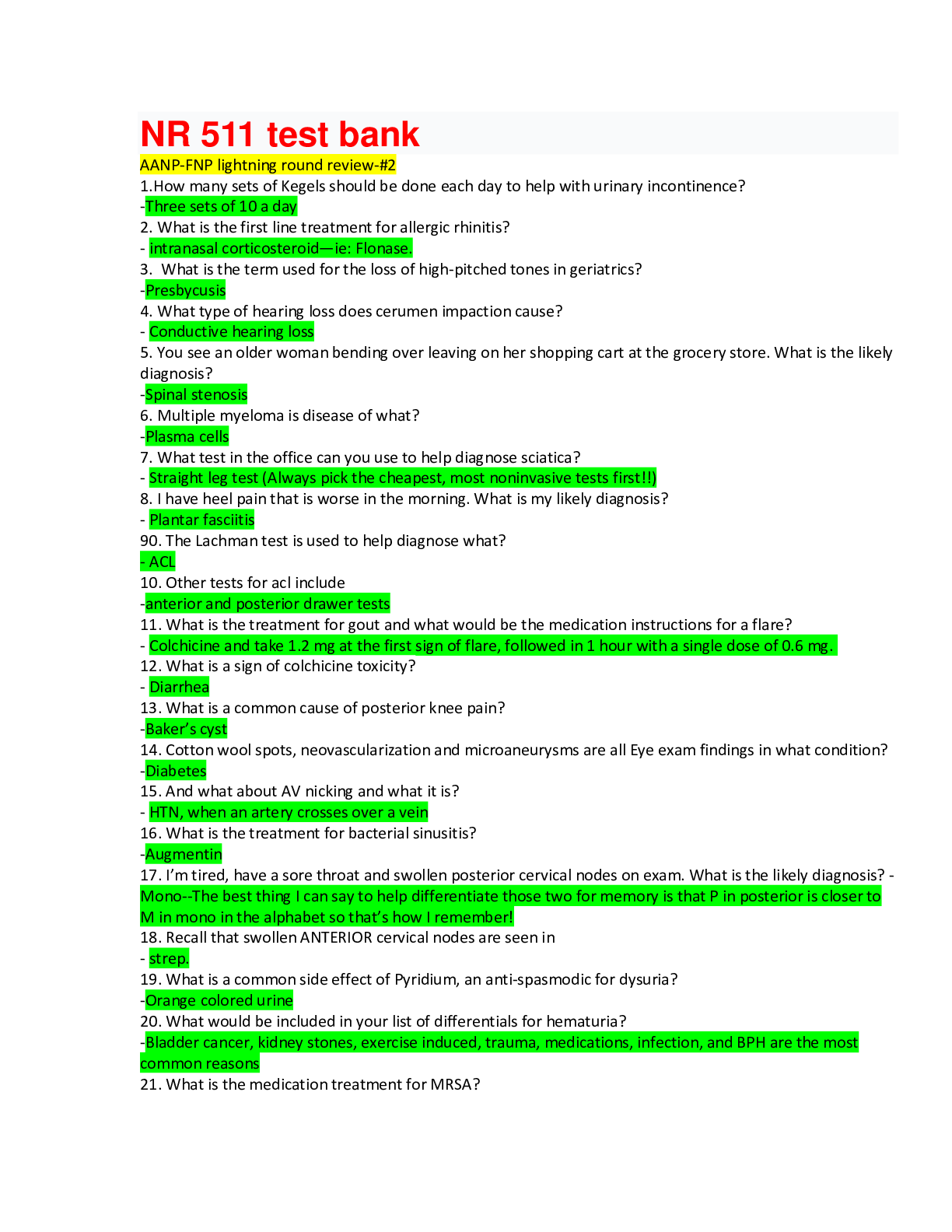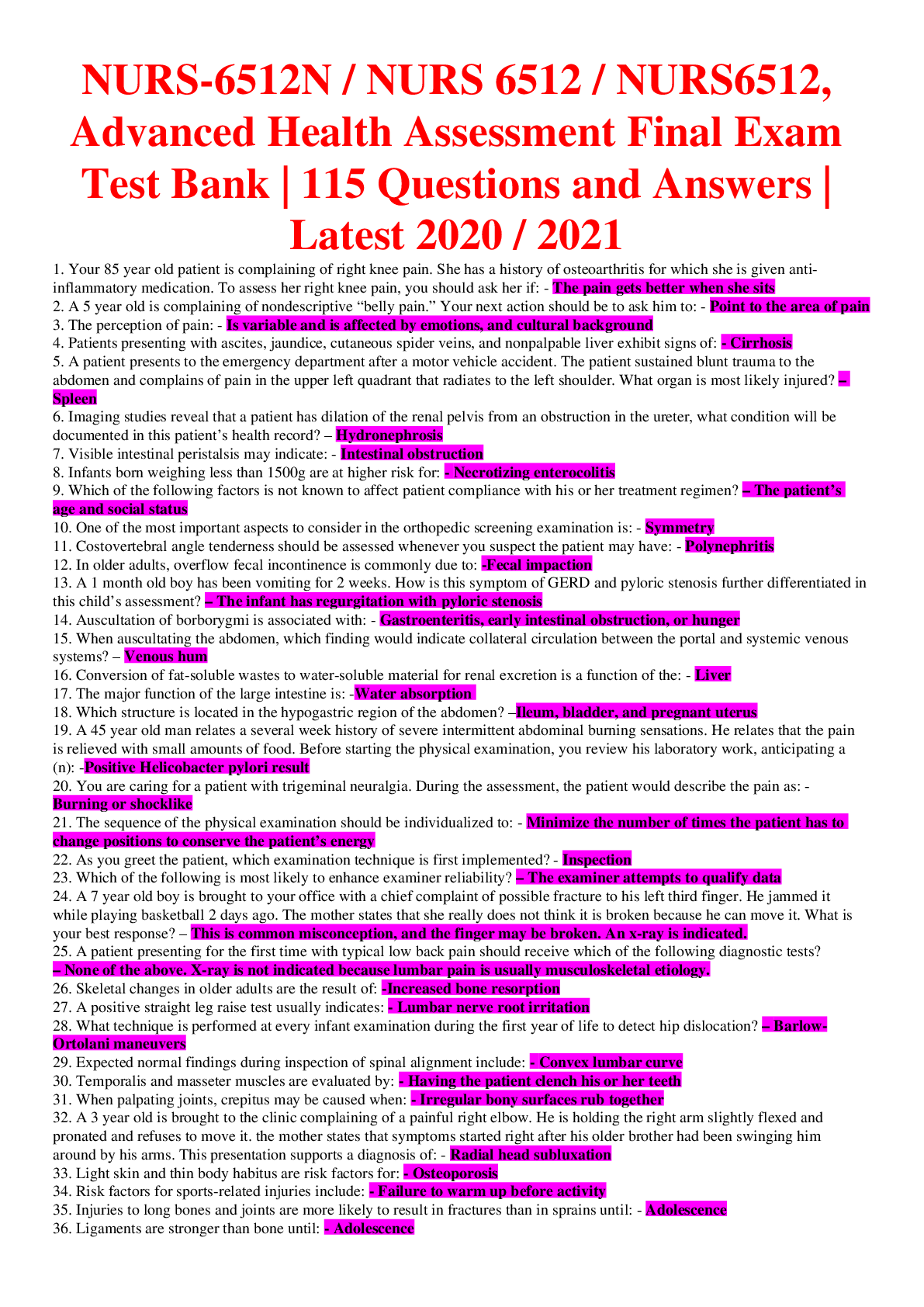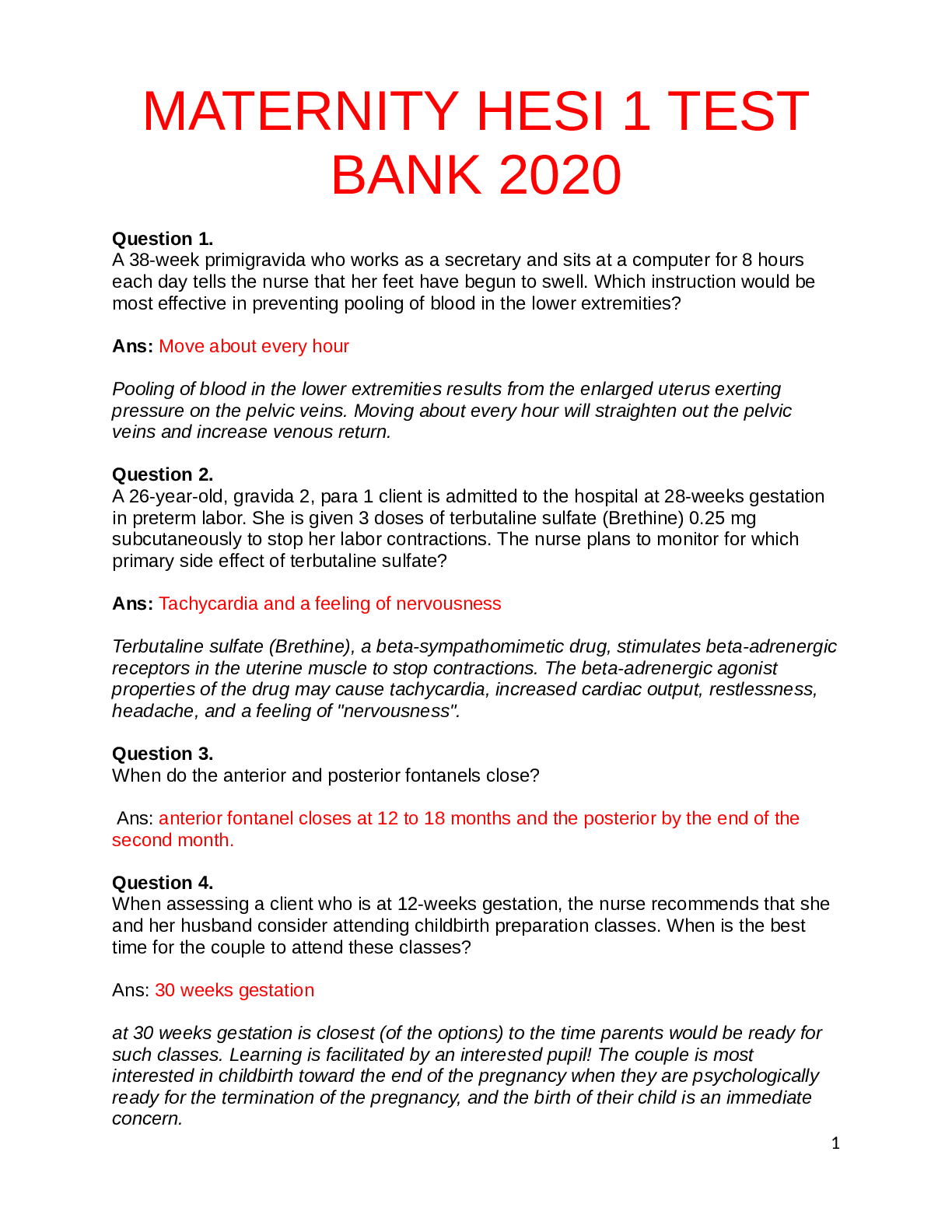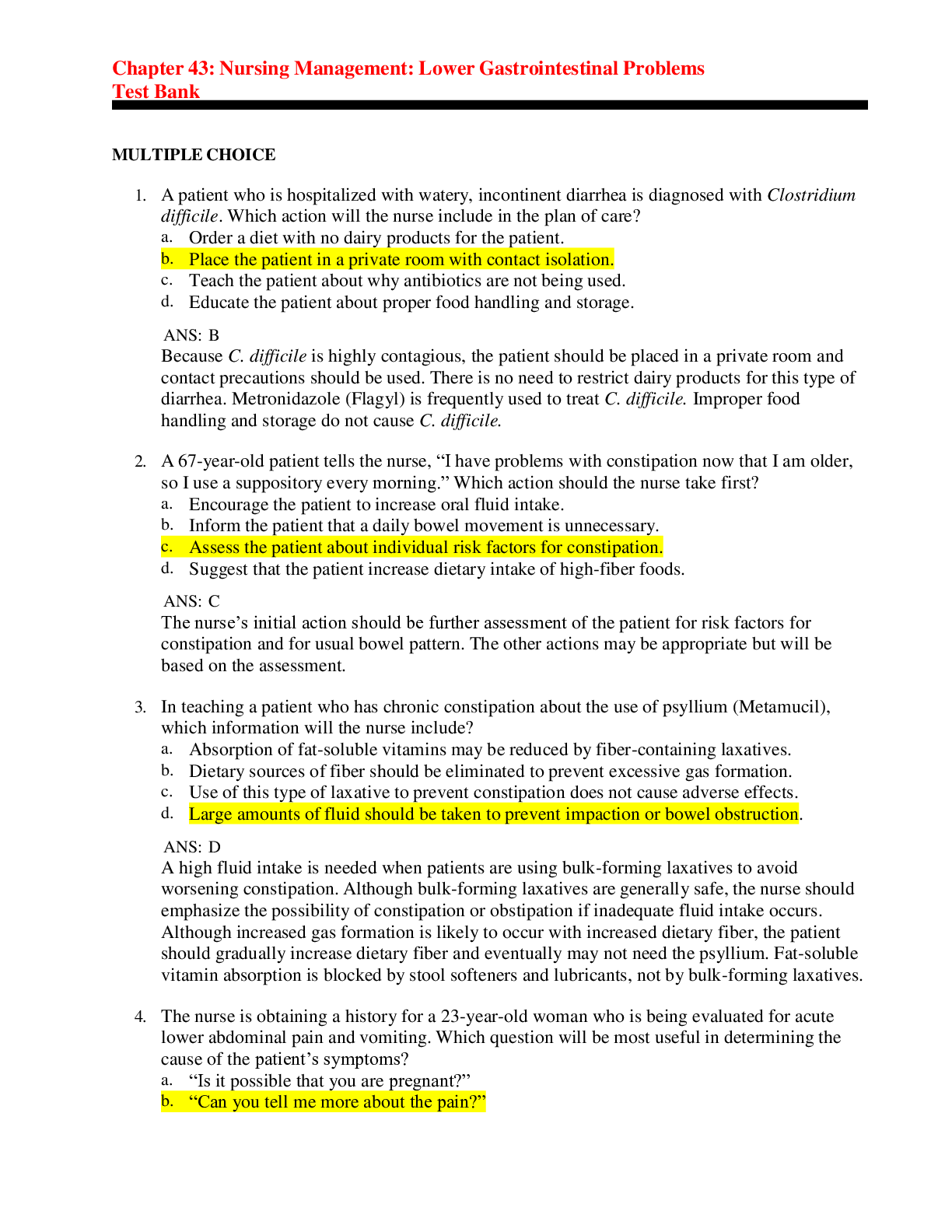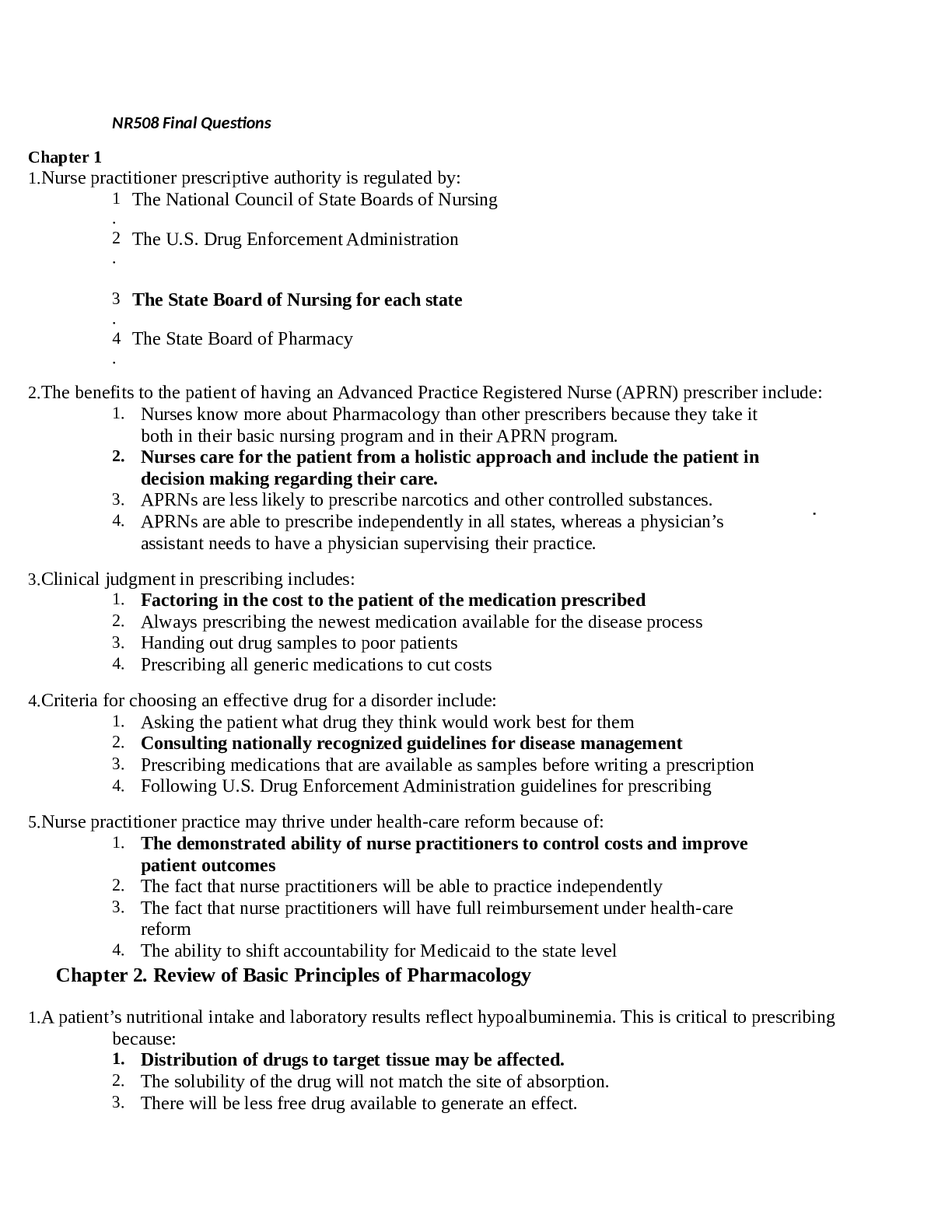NSG 6005 TEST BANK | 100% CORRECT
Document Content and Description Below
For which of the following patients would a comprehensive health history be appropriate? 2. The components of the health history include all of the following except which one? 3. Is the following i... nformation subjective or objective? Mr. M. has shortness of breath that has persisted for the past 10 days; it is worse with activity and relieved by rest. 4. Is the following information subjective or objective? Mr. M. has a respiratory rate of 32 and a pulse rate of 120. 5. The following information is recorded in the health history: “The patient has had abdominal pain for 1 week. The pain lasts for 30 minutes at a time; it comes and goes. The severity is 7 to 9 on a scale of 1 to 10. It is accompanied by nausea and vomiting. It is located in the mid-epigastric area.” Which of these categories does it belong to? 6.The following information is recorded in the health history: “The patient completed 8th grade. He currently lives with his wife and two children. He works on old cars on the weekend. He works in a glass factory during the week.” Which category does it belong to? 7.The following information is recorded in the health history: “I feel really tired.” Which category does it belong to? 8.The following information is recorded in the health history: “Patient denies chest pain, palpitations, orthopnea, and paroxysmal nocturnal dyspnea.” Which category does it belong to? 9. The following information is best placed in which category? “The patient has had three cesarean sections.” 10. The following information is best placed in which category? “The patient had a stent placed in the left anterior descending artery (LAD) in 1999.” 11. The following information is best placed in which category? “The patient was treated for an asthma exacerbation in the hospital last year; the patient has never been intubated.” 1.A patient presents for evaluation of a sharp, aching chest pain which increases with breathing. Which anatomic area would you localize the symptom to?A)MusculoskeletalB)ReproductiveC)UrinaryD)EndocrineAns:AFeedback:Chest pain may be due to a musculoskeletal condition, such as costochondritis or intercostal muscle cramp. This would be worsened by motion of the chest wall. Pleuritic chest pain is also a sharp chest pain which increases with a deep breath. This type of pain can occur with inflammation of the pleura from pneumonia or other conditions and pulmonary embolus. 2.A patient comes to the emergency room for evaluation of shortness of breath. To which anatomic region would you assign the symptom?A)Reproductive B)UrinaryC)CardiacD)HematologicAns:CFeedback:Cardiac disorders such as congestive heart failure are the most likely on this list to result in shortness of breath. There are cases within the other categories which may also result in shortness of breath, such as anemia in the hematologic category, pregnancy in the reproductive category, or sepsis with UTI in the urinary category. This demonstrates the “tension” in clinical reasoning between making sure all possibilities are covered, while still being able to pick the most likely cause. 3.A patient presents for evaluation of a cough. Which of the following anatomic regions can be responsible for a cough?A)OphthalmologicB)AuditoryC)CardiacD)EndocrineAns:CFeedback:The cardiac system can cause a cough if the patient has congestive heart failure. This results in fluid buildup in the lungs, which in turn can cause a cough that produces pink, frothy sputum. A foreign body in the ear may also cause a cough by stimulating Arnold's branch of the vagus nerve, but this is less likely to be seen clinically than heart failure. 4.A 22-year-old advertising copywriter presents for evaluation of joint pain. The pain is new, located in the wrists and fingers bilaterally, with some subjective fever. The patient denies a rash; she also denies recent travel or camping activities. She has a family history significant for rheumatoid arthritis. Based on this information, which of the following pathologic processes would be the most correct?A)InfectiousB)InflammatoryC)HematologicD)TraumaticAns:BFeedback: The description is most consistent with an inflammatory process, although all the other etiologies should be considered. Lyme disease is an infection which commonly causes arthritis, hemophilia is a hematologic condition which can cause bleeding in the joints, and trauma can obviously cause joint pain. Your clinical reasoning skills are important for sorting through all of the data to arrive at the most likely conclusion. 5.A 47-year-old contractor presents for evaluation of neck pain, which has been intermittent for several years. He normally takes over-the-counter medications to ease the pain, but this time they haven't worked as well and he still has discomfort. He recently wallpapered the entire second floor in his house, which caused him great discomfort. The pain resolved with rest. He denies fever, chills, rash, upper respiratory symptoms, trauma, or injury to the neck. Based on this description, what is the most likely pathologic process?A)InfectiousB)NeoplasticC)DegenerativeD)TraumaticAns:CFeedback:The description is most consistent with degenerative arthritis in the neck. The patient has had intermittent symptoms and the questions asked to elicit pertinent negative and positive findings are negative for infectious, traumatic, or neoplastic disease. 6.A 15-year-old high school sophomore comes to the clinic for evaluation of a 3-week history of sneezing; itchy, watery eyes; clear nasal discharge; ear pain; and nonproductive cough. Which is the most likely pathologic process?A)InfectionB)InflammationC)AllergicD)VascularAns:CFeedback:This description is most consistent with allergic rhinitis. 7.A 19-year old-college student presents to the emergency room with fever, headache, and neck pain/stiffness. She is concerned about the possibility of meningococcal meningitis. Several of her dorm mates have been vaccinated, but she hasn't been. Which of the following physical examination descriptions is most consistent with meningitis? A)Head is normocephalic and atraumatic, fundi with sharp discs, neck supple with full range of motionB)Head is normocephalic and atraumatic, fundi with sharp discs, neck with paraspinous muscle spasm and limited range of motion to the rightC)Head is normocephalic and atraumatic, fundi with blurred disc margins, neck tender to palpation, unable to perform range of motionD)Head is normocephalic and atraumatic, fundi with blurred disc margins, neck supple with full range of motionAns:CFeedback:Blurred disc margins are consistent with papilledema, and neck tenderness and lack of range of motion are consistent with neck stiffness, which in this scenario is likely to be caused by meningeal inflammation. Later, you will learn about Kernig's and Brudzinski's signs, which are helpful in testing for meningeal irritation on examination. [Show More]
Last updated: 1 year ago
Preview 1 out of 9 pages
Instant download

Buy this document to get the full access instantly
Instant Download Access after purchase
Add to cartInstant download
Reviews( 0 )
Document information
Connected school, study & course
About the document
Uploaded On
Jan 30, 2021
Number of pages
9
Written in
Additional information
This document has been written for:
Uploaded
Jan 30, 2021
Downloads
0
Views
32












